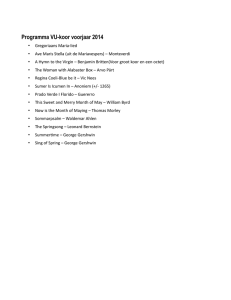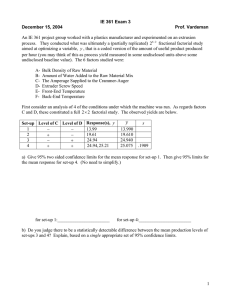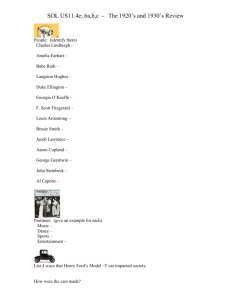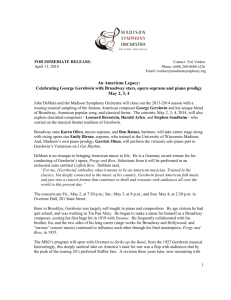Stochastic Scheduling and Set-Ups
advertisement
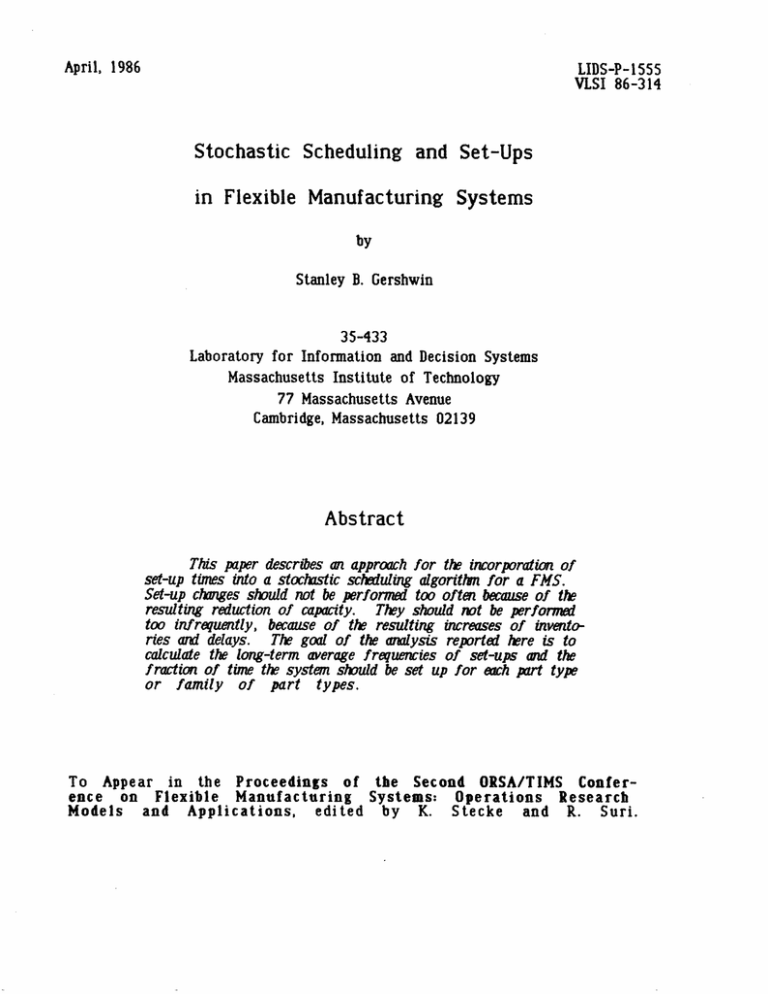
April, 1986 LIDS-P-1555 VLSI 86-314 Stochastic Scheduling and Set-Ups in Flexible Manufacturing Systems by Stanley B. Gershwin 35-433 Laboratory for Information and Decision Systems Massachusetts Institute of Technology 77 Massachusetts Avenue Cambridge, Massachusetts 02139 Abstract This paper describes an approach for the incorporation of set-up times into a stochastic scheduling algoritltn for a FMS. Set-up changes should not be performed too often because of the resulting reduction of capacity. They should not be performed too infrequently, because of the resulting increases of inventories and delays. The goal of the analysis reported here is to calculate the long-term average frequencies of set-ups and the fraction of time the system should be set up for each part type or family of part types. To Appear in the Proceedings of the Second ORSA/TIMS Conference on Flexible Manufacturing Systems: Operations Research Models and Applications, edited by K. Stecke and R. Suri. Stochastic Scheduling and Set-Ups in FMS's 1. Gershwin page 2 Introduction In this paper, we describe an approach for the incorporation of set-up times into an earlier stochastic scheduling algorithm (Kimemia, 1982, and Kimemia and Gershwin, 1983) for a Flexible As before, the objective is to Manufacturing System (FMS]. develop a feedback law which will respond to and mitigate the effects of random, potentially disruptive events. This approach to scheduling differs from conventional mixed In such integer programming representations (Graves, 1981]. formulations, there are a large number of binary or integer variables (for example, Afentakis, Gavish, and Karmarkar, 1984; These approaches model the system Karmarkar and Schrage, 1985). in detail, but their large computational requirements make them difficult to solve and interpret, and adding stochastic phenomena Maxwell and Muckstadt [1985) does not make them any easier. simplify the problem by dealing only with reorder intervals Ku(i.e., set-up frequencies) and ignoring capacity questions. siak, Vanelli, and Kumar [1985) treat only the grouping problem. In the work reported here and in Kimemia (1982) and Kimemia and Gershwin [1983), the approach is to gain as much information as possible from a continuous representation of the flow of Only after solving the continuous probmaterial in the system. The detailed lem is the detailed discrete problem treated. scheduling problem is then much easier than it would be if it were treated without first solving the continuous problem. In that earlier work, however, set-up times were not consiThat is, it was assumed that no time or cost was required dered. for changing tools or other resources that are specific to a In reality, however, even a FMS has limited set of part types. The zero-set-up time assumption limitations on its flexibility. may be adequate for a small set of parts comprising a family, but not for selecting times to change configurations so that a new family can be produced. By configuration we mean a set of tooling that limits the FMS to doing operations on a specific To make parts that are in part type or family of part types. other families, the configuration must be changed. In this paper, we assume that there is a non-zero set-up time. That is, some time is required to change the configuration of the system from making one part type (or family of part types) to making another. This is an issue of practical importance which arises in metal cutting systems, in which tool magazines can hold only a limited number of tools; printed circuit card assembly systems in which each insertion machine can hold only a limited number of types of electronic components; and VLSI fabrication, in which furnaces must be cleared of each kind of impurity before the next kind of impurity can be used. It is not desirable to change the configuration too often because that reduces the amount of time available for productive work and thus the capacity. On the other hand, it is not desir- Stochastic Scheduling and Set-Ups in FMS's Gershwin page 3 able to change it too infrequently, because that will tend to increase inventories and delays before deliveries. The major innovation reported here is the explicit calculation of capacity for scheduling problems with non-zero set-up times. The goal of the analysis is to calculate the long-term average frequencies of set-ups and the average fraction of time that the system is in each configuration (i.e., the fraction of time it is set up for each part type or family of part types]. Further work at the detailed level is required to translate these quantities into times at which to perform set-ups. An essential element of this analysis is the explicit recognition that different events take place at greatly different time scales, i.e., frequencies. At the higher level of the scheduling hierarchy, we calculate set-up frequencies, average production rates, and other long term quantities. The lower level has the responsibility of choosing times to perform set-ups and dispatch parts in a way that agrees with the high level rates. Because the high level analysis has no way of determining exactly when a set-up will take place, but instead only the rates of set-ups, it is reasonable to use the tools of probability. The relationship of this work to longer issues is described in Gershwin (1986). and shorter term In Section 2, we describe a formulation in which the set-up frequency is much less that that of the failures and repairs and production operations. Two examples are worked out in Section 3. Section 4 briefly describes the modifications to the analysis when set-up frequencies are comparable to repair and failure frequencies. We conclude in Section 5. 2. Infrequent Set-Ups In this section, we consider the problem of devising a feedback law for the scheduling of a FMS. We wish to find the optimal production rate for each part type and the frequencies of set-ups. We also seek the fraction of time that the system spends in each configuration. Time Scales We assume that set-up time is not negligible compared to operation time. The horizon is long enough so that reliability behavior (i.e., repairs and failures of machines) may be replaced by average machine efficiency [or possibly by a random variable indicating the amount of material produced during an interval; parts are made often enough so that part flow may be approximated by a continuous function of time; and set-ups occur very many times during the problem horizon. The problem may be assumed to have at least two important time scales. The short time scale is that of machine failures and repairs which is treated by Kimemia and Gershwin [1983) and Gershwin, Akella, and Choong (1985). In that time scale, the system configuration never changes and so Stochastic Scheduling and Set-Ups in FMS's set-ups never occur. the long time scale. Changes Gershwin in configuration page 4 take place over from m Notation S = continuous smk k; the = this wm = is the including long time scale time required specified. fraction time of to time during index change the set-upsl; variable. configuration system this is is in a configuration decision fmk = the frequency that the configuration changes That is, fmk6S is the probability that an observer to m [not variable. from m to k. sees the system change from configuration m to configuration k during val [S, S + bS); this is a decision variable. the inter- the frequency that the configuration changes from m to k while system is in configuration m. That is, mkSS is the probability that an observer sees the system in configuration m change from configuration m to configuration k during the interval (S, S + bS); this is a decision variable. Note that >mk = fmk = Basic Om [2.1) k Wm Equations for Set-up Times in a By accounting for the total time the configuration or having its configuration ZWm + m in,k m Stochastic system can be in any changed, we have (2.2) 1 . -Smkfmk The fraction of time w%[S) uration k at time S satisfies that the wk(S+SS) = wk[S) + 2;Omk Wm[S)]S - ZPkmWk[S) mfk m~k Then, in mZOmk steady Wm Inte rp re tati Environment system is in config- S state, ( kkm )Wk . [2.3) on Equations [2. 1)]-2.3) are similar to the equations for the steady-state probability distribution of a Markov process (in which wm is analogous to the probability of finding the system in state m, and Omk6S is the probability of a transition from m to k in an interval of length bS.) The principal difference is the set-up time term in (2.2), which prevents the probabilities from summing to unity. Stochastic Scheduling and Set-Ups in FMS's In the usual context, P mk Gershwin is known. page 5 There are then enough equations to determine wm (except in singular cases). Here, however, both 0imk and wm must be determined. Additional information is required. Production Requirements, Capacity Constraints, and Inventory Frequent set-ups reduce capacity and make production requirements infeasible. Infrequent set-ups increase cycle times (the time a part spends in the factory) and inventory. To describe these issues, we must introduce additional notation. The subscript L refers to long time scale quantities, to distinguish quantities here from similar short term quantities in Kimemia and Gershwin (1983], Gershwin, Akella, and Choong (1985), and Akella, Choong, and Gershwin (1984). Tij[m) while = the time that part type j requires at machine the system is in configuration m; this is specified. production rate of type j parts while configuration m; this is a decision variable. uLj = the LL scale city the system is i in the long time scale capacity set. The long time production rate vector satisfies the long time scale capaconstraints: ULI(S) E uj- 0, u Tij(m) uj < Eji (2.4) while the system is in configuration m. Here ai refers to the repair state of machine i, and Eo i is the average availability of machine i over the time scale treated here. This issue and notation are discussed in Kimemia and Gershwin (1983) and Gershwin, Akella, and Choong (1985). dj = the long specified. dLi = term In order [ to average satisfy demand for demand, we part type j; this is must have (2.5) Wm ULi Equation (2.2) indicates that as fmk increases, wm If w m is too small (i.e., if the system does not decreases. spend enough time producing), then (2.5) may not be satisfied for any feasible u. Therefore, [2.5) imposes an upper limit on setup frequency. xLj[S] = the difference between cumulative production cumulative demand for type j at time S; this is a decision able. The dynamics of x are and vari- Stochastic Scheduling and Set-Ups in FMS's L=UL (j - where mrS] An is Gershwin page 6 dtj. the 2.6) configuration optimization problem at is time S. (2.1)-(2.4), (2.6), and (2.7) J XL(S)) = JgL[(xL(s))ds where g is a measure of cost of surplus (x positive) or backlog [x negative). This is similar to the problem in Kimemia and Gershwin [1983) in which flow rates are chosen to respond to changes in machine repair states, rather than configurations. Implementation: The solution is uL([S, w, and f or p. 0 indicates how frequently to change configurations. An algorithm must be found to determine the actual set-up instants so that the actual frequencies are as close to this as possible. One possible approach is to follow the earlier Gershwin, Akella, and Choong [1985) method for the lower level. Here, we let WM(S) = wmS . (2.8) This is the calculated amount of time that the system should have been in configuration m in [0,S). Let WNm[S] be the actual amount of time the system has been in configuration m between times 0 and S. Change the configuration to m whenever WNm(S) < Wm(S]). 2.8) An alternative rule would be to change set-ups when all XLi of the current configuration have reached a specified value. the Relationship with earlier work: Figure 2.1 shows the relationship of the work described in this appendix with the earlier (Kimemia and Gershwin, 1983) algorithm. The long term average demand rate dL is specified at a still higher level. The problem (2.7) is solved and the results are used in two ways: ufM is used as the demand rate d for the lower level algorithm; and p and w are used to calculate set-up frequencies and actual set-up times. When the configuration (m) and the average demand rate d are specified, the lower level (k-g) algorithm can be run. 3. Examples Example with Infrequent Set-Ups 1 Consider a flexible manufacturing system that makes three The system consists of one part types in two configurations. In configuramachine that has holders for two different tools. tion 1, the system can make types 1 and 2; in configuration 2, it It takes one hour on the average to do can make types I and 3. page 7 Gershwin Stochastic Scheduling and Set-Ups in FMS's an operation on any part (after reliability count], so the capacity sets are: is taken into ac- For m=l, ul + u' < 1 where the [3.1) superscript refers to the system configuration, and for m=2, u 2 + u2 The 1. demands 3.2) are = di .3; d2 = .2; d3 = .4 parts per hour. Instead of considering the dynamic optimization problem, we treat To satisfy demand, we must have the system in steady state. w ul +w 2u' .3 = .2 wlul w 22u 23 (3.3) .4 Because there are only two configurations, and because assume that the system is in steady state, (2.3) becomes we (3.4) 012W1 = 0 2 1W2 . It takes s12 hours to change the tools from configuration to 2, and s2l hours to change back. The normalization equation (2.2) is then W 1 + W2 The + S 21 0 2 1W 2 = + S1 2 012W last two 1 equations [3.5 1 imply 1 that t12 _ + 1 + +2+ Equation u2 u 0122 S12 + S21 (3.3) now becomes .3(1 1= 021 -2 12 + 521 0 12+ 1 + 1 21 + s,2 + S12 1 + S21 + S21 ) (3.8) Stochastic Scheduling and Set-Ups in FMS's -.4 21 -!-+ (412 From + + s 21 + 12 Gershwin page 8 (3.9) ) 21 (3.3], WI + w 2 > .9 3.10) + 1 (3.11) or, I 012 21 - 9(s 12 + S21) Instead of dealing with optimization problem (2.7), we assume that (3.1), (3.2), and 3.11]) are satisfied with equality. We now have 6 equations ((3.1), [3.2), (3.7), (3.8), (3.9), (3.11)) in 6 unknowns (ut, u2, u2, u, 0 12 , ¢21X3 However, there is The additional equation can one redundant equation among them. be supplied by a simplified lower level model in which we minimize an estimate of the buffer space required due to batching. The results are 1 = 2 ~12 = 1 U1 -9 = .45 = 921 9[S12 5 + S21i 1 4 U2 - 9 The system's operation proceeds as follows: it may start configuration 1, for example, producing type 1 and 2 pieces at rate 5/9 and 4/9 pieces per hour, respectively. These quantities are averages since we have assumed that the system actually suffers numerous repairs and failures while it is in each configuration. After about 2/(9(s1 2 + s21)) hours, we start changing over to configuration 2. This takes sI2 hours. Production starts up again in configuration 2 in which type 1 and 3 pieces are made at rates 1/9 and 8/9 pieces per hour. The system stays in this configuration for about 2/(9(s1 2 + s21)] hours, and then the next changeover begins. It takes s21 hours and the system is in configuration 1 again. Note that only the sum of the set-up times important in this problem, and not the individual sum increases, set-ups are performed less often. sl2 + s21 times. in is As the The decision of precisely when the changeover will take place is left up to the lower level. The quantities calculated here are requirements that the lower level must satisfy. StocfrMstic Scheduling ad Set-Ups in FMS's Example Gershwin page 9 2 Consider a machine that does operations on three classes of parts: finished [type 1 parts), semi-finished (type 2), and rough (type 3). The same tool can be used for any of the parts, but it is worn by use. Once it is used for semi-finished operations, it cannot be used for finished operations; and once it is used for rough operations, it cannot be used for finished or semi-finished operations. Thus, there is no changeover time in changing from finished to semi-finished or semi-finished to rough operations, since there is no tool change involved. Any other change does cost some time. Assume that the operation times and set-up times (when non-zero) are all 10 minutes. Thus (10, if i = j co, otherwise Tj(i)] = (3.12) and S12 =S23 =S13 S21 = S31 -= 0 10 = S32 = Assume d1 = .02 } d2 .03 > parts per minute. (3.14) d3 = .04 This implies 0 < u1 < .1 0 < u 2 < .1 0 < U3 < .1 If we that and assume w lu = .02 = .03 w 3u 3 = .04 (3.15) w 2u 2 that ui is always at its maximum value, then w I = .2 W2 = .3 (3.16) W 3 = .4 This implies that (2.2) can be written (3.17) 202 1 + 30 3 1 + 3(32 = .1 Equation (2.3) becomes, in this example, (3.18] 3¢21 + 40 3 1 = 2P1 2 + 20 1 3 2012 + 4032 = 3 There is previous two. Instead a of (3.19) + 3023 . +21 third equation solving the in (2.3), optimization but it problem is implied by the (2.7), we make Stochastic Scheduling and Set-Ups in FMS's page 10 Gershwin on the average, during the following simplifying assumption: each period that the system is in configuration j (i.e., capable of operating on type j parts), it produces Kdj type j parts. Since the average length of time it is in configuration 1 is I 012 + 013 and the average production rate in that state is .1, then [3.20] .1 = .02K 012 + 013 Similarly, .1 = .03K (3.21) = .04K. (3.22] 021 + 023 .1 031 + 032 The solution 12 ~12 - 023 10625 K is: .075 [3.23) (3.24) = 312 [3.25) 031 = 2(12 2012 2121== O ¢13 ¢32 in = 05 - 3.725 K (3.26) 3[ 2=¢21 (3.27) 32 4¢21 (3.28] which 75 < K <425 3 so that all quantities above are non-negative. still not quite complete; the quantity K must Inte rp re tati and The solution is be determined. on The solution has isolated two set-up cycles; 1 - 2 - 3 - 1 The first requires less set-up time, but the 2 - 1 - 3 - 2. The system's behavior will be second may be preferred sometimes. The cycle to be chosen at any time a mixture of the two cycles. may depend on the amount of each part type that has been produced. Other cycles are possible, such as 1 - 2 - 1. These partial cycles are not sufficient by themselves, but they may be selected if, for example, the production of type 3 parts is in excess compared with types 1 and 2. Stochastic Scheduling and Set-Ups in FMS's 4. More Frequent Gershwin page 11 Set-Ups In Sections 2 and 3, changes of configurations are assumed In to be much less frequent that machine failures and repairs. cases where these events occur at about the same frequencies, we can modify the definition of "configuration" to include failure state. That is, m now refers not only to the kind of tooling present at any instant, but also the failure state of the system. It includes a as defined by Kimemia and Gershwin [1983). The equations of Section 2 are largely unchanged, but they must be interpreted differently since the time scale is shorter. Some components of 0(mk are specified quantities: the repair and failure rates of some machines. The rest are decision variables with the same meanings as in Sections 2 and 3. Equation [2.4) must um E m= ( uu uj>O, where aiE(m) is the configuration m. 5. be modified repair ij(m) u state < as follows: 4.1 o(m)} of machine i corresponding to Conclusion This paper suggests an approach to incorporating set-up times into the earlier Kimemia-Gershwin scheduling method for unreliable FMS's. It follows the strategy of sidestepping the detailed combinatorial analysis that would be required if we represented each set-up event and each part explicitly. Instead, we deal with the rates of these events, and this greatly reduces the computational load. Future work includes the development of the lower level algorithms. These algorithms must carry out the guidelines calculated here. It also includes the understanding of set-up cycles described in Example 2. Other related work is devising strategies for assigning parts to families; that is, deciding Finally, the widely what will each configuration be able to do. used concept of hierarchical decomposition of scheduling algorithms should be examined, so that there is a systematic method for assigning issues to hierarchical levels. Stochastic Scheduling and Set-Ups in FMS's Gershwin page 12 REFERENCES P. Afentakis, B. Gavish, and U. S. Karmarkar [1984), "Computationally Efficient Optimal Solutions to the Lot-Sizing Problem in Multistage Assembly Systems," Management Science, Vol. 30, No. 2, February, 1984. R. Akella, Y. F. Choong, and S. B. Gershwin [1984), "Performance of Hierarchical Production Scheduling Policy," IEEE Transactions on Components, Hybrids, and Manufacturing Technology, Vol. CHMT-7, No. 3, September, 1984. S. B. Gershwin, (1986), "An Approach to Hierarchical Production Planning and Scheduling," Proceedings of the Symposium on Real-Time Optimization in Automated Manufacturing Facilities, January, 1986. S. B. Gershwin, R. Akella, and Y. F. Choong [1985), "Short-Term Production Scheduling of an Automated Manufacturing Facility," IBM Journal of Research and Development, Vol. 29, No. 4, pp 392-400, July, 1985. S. B. Gershwin, M. Athans, E. R. Ducot, and J. G. Kimemia (1982), Systems Aspects of Flexible Automated Manufacturing Networks," MIT Laboratory for Information and Decision Systems Report LIDSFR-1202, April, 1982. S. B. Gershwin, S. C. Graves, Y. F. Choong, R. Akella (1985), "Control of Material Flow in Manufacturing Systems," Draft of MIT Laboratory for Information and Decision Systems Final Report. S. C. Graves [1981), "A Review Operations Research, Vol. 29, August, 1981. of Production Scheduling," No. 4, pp 646-675, July- J. G. Kimemia [1982), "Hierarchical Control of Production in Flexible Manufacturing Systems," MIT Laboratory for Information and Decision Systems Report LIDS-TH-1215. J. G. Kimemia and S. B. Gershwin [1983), "An Algorithm for the Computer Control of a Flexible Manufacturing System," IIE Transactions Vol. 15, No. 4, pp 353-362 December, 1983. U. S. Karmarkar and L. Schrage (1985), The Deterministic Dynamic Product Cycling Problem," Operations Research, Volume 33, No. 2, March-April 1985, pp 326-345. A. Kusiak, A. Vanelli, and K. R. Kumar [1985), "Grouping Problem in Scheduling Flexible Manufacturing Systems," Robotica, Volume 3, pp 245-252. W. Maxwell and J. Muckstadt [1985), "Establishing Consistent and Realistic Reorder Intervals in Production-Distribution Systems," Operations Research, Volume 33, No. 6, November-December 1985, pp 1316-1341. Gershwin Stoclxstic Scheduling and Set-Ups in FMS's page 13 IdL specified determination of 0, f, w, UL I calculate d=uL set-up instants ml k-g* top level: calculation of LP coefficients k-g middle level: LP k-g bottom level: dispatch times machines I Figure 1. The Production Algorithm I * Kimemia and Gershwin (1983). Acknowledgments I am grateful for discussions with Yong F. Choong, Sheldon This work was sponsored by the Lou, and Loren K. Platzman. Defense Advanced Projects Agency and monitored by the Office of Naval Research under Contract N00014-85K-0213.
